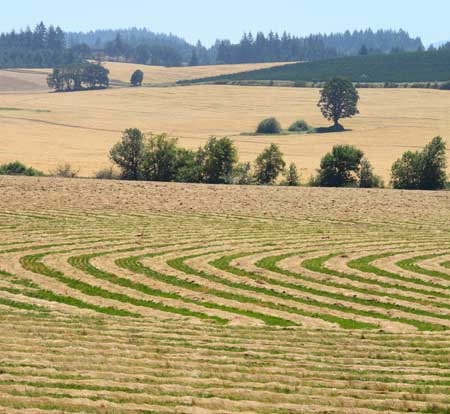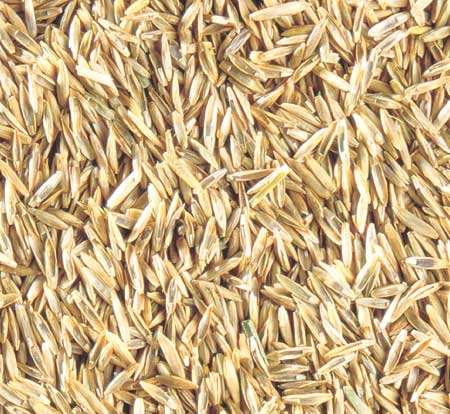As seen in Connecticut Magazine, October 2019
We usually think of spring as the best time to plant flowers, bare-root trees and, especially, grass. After all, spring brings an increase in sunlight and a consistent dose of rain showers. It may come as a surprise, however, that one of the best times to plant and nurture turfgrass is actually in autumn. Establishing a new lawn by seed, or thickening up your existing lawn during the fall, will benefit your turfgrass in several ways, including one key factor: long and healthy root development. Planting in fall enables lawns to experience two periods of active root growth before the hot weather sets in and the high-traffic summer season arrives.
Establishing turfgrass in fall also reduces watering requirements come summer. This is due to the longer roots being able to more easily draw moisture from deeper in the soil. What’s more, soil temperatures are more favorable for the growth of cool season turfgrasses during the fall, whereas the spring/summer grassy weeds, including crabgrass, slow down and won’t compete as harshly with the establishing turfgrasses.
“Once temperatures are consistently below 60 degrees, your lawn will start storing up nutrients in preparation for winter. That’s when you should start your fall lawn care regime,” says Bryan Ostlund, executive director of Grass Seed USA, a national coalition of grass seed farmers and academic turf specialists.
The benefits of lawns are often overlooked, yet a healthy lawn serves several critical functions. Turfgrass lawns serve to sequester carbon, filter air and water particulates, reduce ground surface temperatures, reduce noise, improve the look of the landscape and increase property values. While we most commonly associate trees with carbon reduction, turfgrasses also absorb CO2 and produce O2. A dense, healthy well-maintained lawn actually reduces our carbon footprint. According to The Lawn Institute, a lawn that covers as little as 50 ft2 releases enough oxygen to support a family of four.
Turfgrass is also very efficient and important in preventing soil erosion. Whether during windy periods, rainstorms, or worse, the turfgrass roots’ natural anchoring systems keep soil in place and potential water damage at bay. Every turfgrass plant that establishes in the soil, slows possible water runoff that may lead to erosion. Fall lawn care, such as planting in bare areas or reseeding thinned out turf, establishes a root matrix that immediately benefits the lawn and leads to an even stronger root system during snowmelt, spring rains and summer thunderstorms.
What’s more, putting a bit of effort into your lawn this fall by overseeding and fertilizing your lawn, may reduce the need for early spring and summer maintenance next year. Seeding in the fall will help your lawn start out thicker and with fewer weeds come spring, jumpstarting your ability to sit back, relax and enjoy your beautiful lawn.
Advises director Ostlund, “Investing a bit of time and effort in fall maintenance will pay off next year, with greener grass earlier in the spring and a thicker, healthier lawn that is ready to stand up to the rigors of summer wear and tear.”
So, what does fall lawncare look like? First, home lawns benefit greatly from well-chosen grass seed. Turfgrass naturally self-repairs and by selecting the right seed blend for your conditions, grass can be an easy-to-maintain, long lasting groundcover option. The more years your lawn grows vigorously with regular attention, the more resilient it becomes against every form of stress from droughts to hard frost to daily foot traffic.
Choosing the right seed for your specific growing area is as important as selecting the proper flowers for your garden. Begin by having your soil tested to learn its exact makeup and nutrient levels. Take the results to your local nursery, master gardener, or work with your university extension specialist or lawncare technician, to select an appropriate turfgrass seed blend that works for your area. There are turfgrass varieties for practically every location!
If you buy and apply seed on your own, be sure to read the seed label on each bag of grass seed to confirm that it has been tested within the last six months and possesses a germination rate that exceeds 85 percent.
Next it’s time to prep the area with a straight rake to remove dead material and fluff the top ½ inch of topsoil. The experts at Grass Seed USA also recommend aerating before you seed. Aerating at least once a year is part of a general lawn maintenance regimen and helps grass seed get down into your soil. There are several methods and tools for aerification, check with your local nursery or hardware store or contact a local landscape professional. The experts at Grass Seed USA also recommend top dressing the soil after aeration with soil, compost or sand (based on your soil test) at a ¼ inch depth.
For homeowners struggling with crabgrass in their lawn, fall is a great time to overseed into those areas. “As the crabgrass dies, mow off the remaining crabgrass plants and broadcast or slice seed new grass seed into open soil areas,” said Victoria Wallace, extension educator at University of Connecticut. “Seeding in the fall will allow the new turf to germinate and give it a head start in the spring as the temperatures start to warm.”
Finally, fertilize. Before applying fertilizer, talk with your university extension specialist or gardening expert about your soil test results. “Fertilize based on soil test needs. Older established lawns (10 plus years) may require less fertilizer than more recently established lawns as more soil organic matter is available to provide nutrients for the lawn,” instructs Wallace. According to research at University of Connecticut, the last fall fertilization of home lawns should be completed around the middle of October.
We may think of autumn as a time when our grass and other plants “fall back” into dormancy, yet grass roots continue to spread and anchor the turf, adding oxygen to our atmosphere, preventing erosion and providing beauty for the remainder of the year. Visit Grass Seed USA for more easy tips and tricks to enhance or create a sustainable, natural turf lawn this autumn.



